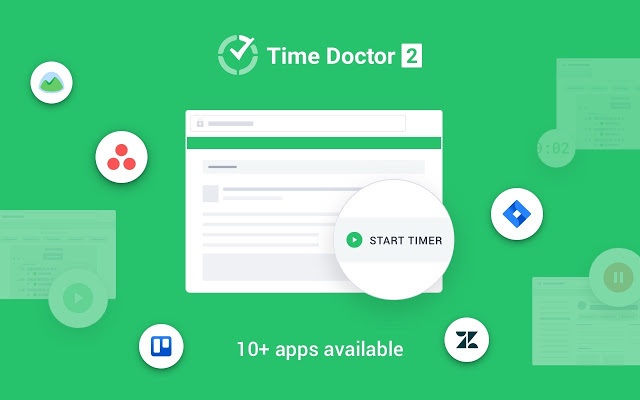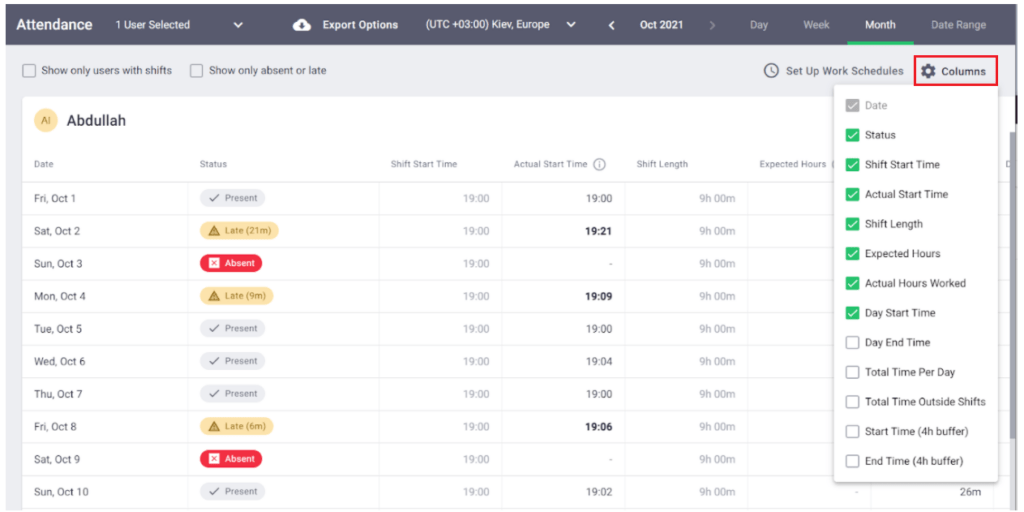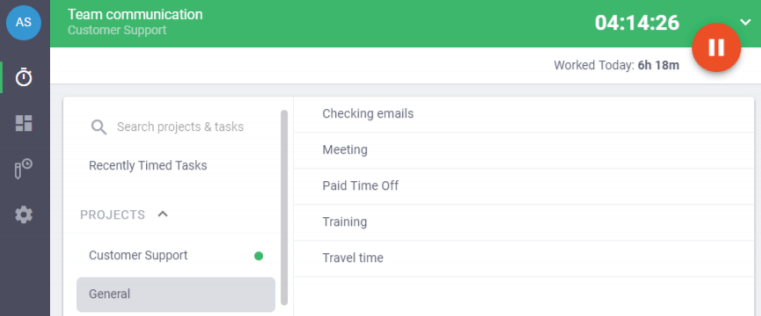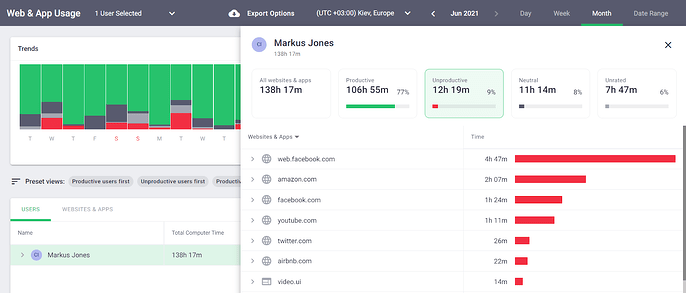You rely on your employees to deliver top-notch services and meet business objectives.
Naturally, you need to account for their paid time off (or annual leave), sick leaves, and other inevitable emergencies which may cause them to skip a day of work.
Tracking employee attendance and proactively monitoring their leaves can help you develop a contingency plan in their absence. This way, your business operations can continue uninterrupted.
In this article, we’ll share the free printable employee attendance calendar that you can use to boost workplace productivity. We’ll also highlight the pros and cons of using the Excel calendar template and suggest a smarter, digital alternative to the printable calendar.
This article contains:
(Click on the links below to jump to a specific section)
- Free Printable Employee Attendance Calendar (Excel, PDF, Word)
- What is an Employee Attendance Calendar?
- 3 Advantages of Using an Employee Attendance Calendar
- 3 Disadvantages of Tracking Employee Attendance Manually
- Track Employee Attendance Digitally with Time Doctor
Let’s get started!
Free printable employee attendance calendar
An employee attendance calendar records the employee’s total number of working days and highlights the reason for absences in a given month.
Here is an employee attendance sheet template (including a blank calendar and sample calendar for reference) to help you with leave management.
You can download it for free in Google Sheet, MS Word, MS Excel, and PDF format.
Note: If you want to know more about an employee attendance calendar template, jump ahead to this section. You can always scroll back here to download the free calendar template.

Download Links:
What is an employee attendance calendar?
An employee attendance calendar is a yearly calendar that can help you register daily attendance and keep the data ready in a printable format.
You can create a separate Excel template for each employee to track their working days and leaves.
While you can record attendance even on a ring binder or wall calendar, maintaining an Excel spreadsheet is the more professional way to go about it. Some companies even issue their employees swipe time cards (resembling a credit card) for attendance tracking.
The yearly calendar contains details like the employee’s full name, the supervisor they’re reporting to, and a list of attendance codes to track employee absenteeism.
Moreover, you can customize this holiday planner template and enter other details according to your company’s leave policies.
Academic institutions can also refer to the attendance sheet template and use it as a school year calendar.
The list of codes includes, but is not limited to, annual leave, sick leave, federal holidays, medical emergencies, etc. While other leaves can vary from employee to employee, public holidays will remain common for all your employees.
The attendance sheet template helps you prepare an employee shift calendar to keep them accountable for their tasks.
Now that we know the purpose of maintaining an employee attendance calendar, let’s check out the advantages of using the attendance sheet template.
3 advantages of using an employee attendance calendar
The employee vacation tracker in an Excel format allows you to identify attendance issues and mitigate business risks.
Here are the three benefits of using the free printable employee attendance calendar.
1. Tracks employee leaves and performance
Businesses allow employees a specific number of paid leaves for the whole year. And with the employee attendance calendar, you can track the leaves they’ve already availed.
This way, you’ll be aware of the remaining leaves for each employee in the yearly calendar.
You can use it as a vacation planner template to mark the days when an employee won’t be available. The employee vacation planner template can help you get a proper replacement for that employee in advance to take charge of the monthly assignments.
The Excel calendar template also gives you an idea of who is doing overtime or making unplanned absences. This data can help evaluate your employee’s performance during appraisals.
You can recognize the top-performing employees with consistent attendance and assign them more responsibilities.
2. Enables proper distribution of workload
The attendance calendar template informs you about your employees’ planned leaves in the upcoming months. This, in turn, helps you in the decision-making process while selecting team members for a new project.
So you can delegate more duties to employees who are not planning an extended leave of absence during the crucial stages of project planning and execution. You can roughly create the employee schedule based on their leave requests and holiday calendar.
You can get information about your available resources from the monthly calendar template and plan the project stages or schedule meetings in the Google Calendar accordingly. It helps you improve the team productivity, keeps their morale high, and reduces employee burnout.
The attendance tracker template allows you to use your resources to the fullest potential and cover all the bases to prevent work disruption.
3. Assists with payroll management
You can use the printable calendar template to estimate the working days of each employee accurately. Based on this data, you can calculate their payable amount due at the end of every month.
You can also identify attendance issues at a glance like tardiness, excess leaves, half days, early checkout, etc., from the free printable calendar. So you can take disciplinary actions and make the exact deductions from their payroll.
Additionally, following the printable monthly calendar template allows you to track the overtime work hours of an employee. It helps you decide their bonus amount and acknowledge their hard work.
In short, the Excel calendar template ensures that your employees aren’t underpaid, leading to reduced work motivation or overpaid, resulting in company losses.
Maintaining the employee attendance sheet helps you simplify the payroll process and keep an accurate attendance record.
However, the employee attendance calendar also comes with certain limitations, especially if you decide to track the attendance using an Excel calendar.
So before you decide to create an employee shift planner and calendar template in Excel, you should go over the next section highlighting its significant disadvantages.
3 disadvantages of tracking employee attendance manually
An Excel calendar template is not always the ideal solution for tracking employee absences. Here are the disadvantages of using a non-digital employee attendance calendar.
1. Increases chances of errors
Even a single wrong entry in the Excel calendar can disrupt the team workflow.
For instance, let’s say an employee submits a leave request for the 13th of a particular month, but in the holiday calendar, you mark the 31st as the vacation day.
Such an error in the vacation planner template can entirely change the course of your project execution. You may end up having no backup resource on the actual vacation day to handle specific tasks and risk upsetting your clients or customers.
Additionally, such inconsistencies in the printable monthly calendar can increase the risks of payroll issues leading to incorrect payments.
The attendance calendar in Excel will also require you to mark the federal holidays like Veterans Day, Memorial Day, or other public holidays with extreme precision. Unless you’re very thorough, you can miss the holidays to which employees are entitled.
Humans are prone to errors. And tracking employee attendance is not the only task in a typical workday. So you may end up building on an inaccurate attendance record while juggling multiple tasks.
2. Tends to be time-consuming
Attendance management in Excel or Adobe PDF entails a lot of manual labor.
You’ll have to dedicate a considerable amount of time to fill out the vacation days of each employee and create an organized employee attendance sheet.
Moreover, the complexity of the printable monthly calendar increases with the size of your team. You have to maintain a separate Excel template for each employee manually.
With the printable calendar template, you cannot archive, filter, or retrieve the exact information for a particular employee quickly enough. Instead, you’ll have to scroll through the entire data to find the specific attendance information you’re looking for.
Fortunately, you can overcome these problems by choosing a more efficient way of keeping the employee attendance record.
Track employee attendance digitally with Time Doctor
As a manager, you need an attendance tracking system that is reliable, error-free, and minimizes manual labor. Unfortunately, a printable attendance calendar card does not tick all these boxes.
While a printable and paper-based employee attendance sheet can help you track employee leaves, a digital tool like Time Doctor can save you a lot of time and effort in executing the same tasks.
What is Time Doctor?

Time Doctor is a powerful employee attendance management app that helps you track team attendance and generate productivity reports.
This productivity tool is preferred by large enterprises like Ericsson, as well as by small businesses, like Thrive Market, to enhance organizational performance.
With Time Doctor’s attendance report feature, you can check which employees are absent or present on any given day in the year. It offers the shift planner functionality, allowing you to identify employees who are following the shift timings diligently.
You can even use the tool’s time tracking feature to track your employee’s work hours, review timesheets, and approve payroll.
Here’s how Time Doctor helps you track employee attendance and boost team efficiency effortlessly:
A. Generate employee attendance reports
With Time Doctor, you can check if a particular employee is working, taking a half-day, or simply unavailable.
To access the employee attendance details in Time Doctor, you’ll first have to activate the Work Schedules feature from the Company Settings page.
Once this is done, you can view details like the shift start time, the expected shift length, and the actual hours worked by the employee during the shift.

Attendance reports in Time Doctor can help you evaluate the performance of your employees and record daily attendance with zero hassles.
The report contains four types of attendance statuses:
- Present: Ideally, you can decide on the employee shift length, and if they’ve worked the minimum number of required hours in a given day, they’re marked present.
- Absent: If no working hours are tracked for a particular employee, they’re marked absent. It also indicates that they’re either on sick leave or paid leave or away for some scheduled appointment.
- Partially absent: If an employee has worked less than their minimum required hours, they fall under this category.
- Late: If an employee didn’t log in and track time within the first five minutes of their shift, they’re marked late.
B. Monitor employee work hours
The time tracking feature of Time Doctor can help you improve your employee’s everyday efficiency at work.
Besides tracking the attendance for record keeping purposes, you can track their work hours (both manually and automatically).
Here’s how your employees can use the manual/interactive time tracking feature on Time Doctor:
- Open the app and enter the task name
- Press Start to start tracking the time.
- Hit Stop when the task is complete or if you want to pause for some time.
- One can move to other tasks and continue recording the time, in the same way, using the timer button.

The benefit of using the automatic time tracking mode is that the timer starts as soon as the employees switch on their systems. It allows them to focus on the work instead of worrying about starting or stopping the timer every single time.
C. Assess work progress and productivity
Besides tracking the employee working hours and their scheduled time off, managers can access Time Doctor’s detailed reports to assess the work progress.
Here are the productivity reports offered by Time Doctor:
- Activity summary report: Get information on your employee’s active working hours and unproductive time for any week.
- Hours tracked report: Calculate the total number of hours your employees have worked in a week on their tasks.
- Timeline report: Go over daily and weekly reports on the time employees spend on breaks and their tasks. Here you can monitor their weekly schedule and check if it’s in sync with the work schedule.
- Projects and Tasks report: Track the time employees spend on different tasks and projects in a given week.
- Web and app usage report: Analyze employee productivity by checking their time on different apps and websites.

Final thoughts
An employee attendance calendar helps you track your employees’ planned leaves and streamline internal workflows. So you can download the printable calendar template for leave management.
However, maintaining the printable attendance planner is a labor-intensive job that increases paperwork and chances of human error.
So why not opt for a tool like Time Doctor, which can scale your work pace and productivity?
Apart from tracking the total billable hours, the tool lets you manage work schedules, assign tasks and projects, and offers integration with tons of workplace apps.
Sign up for a 14-day free trial today and track your team’s attendance effectively!

Carlo Borja is the Content Marketing Manager of Time Doctor, a workforce analytics software for distributed teams. He is a remote work advocate, a father and a coffee junkie.


